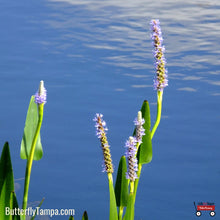Pontederia cordata, common name pickerelweed or pickerelweed, is a perennial emergent aquatic plant native to the American continent. It grows in a variety of wetlands, including pond and lake margins. It can reach 3-4' in height. The stems and leaves emerge annually from a thick pad of fibrous roots. It seldom grows in water above 3 feet in depth.
Pickerelweed's deep green, waxy leaves emerge at the end of the stems. They are quite variable in shape and size. They are arrowhead or heart-shaped, ranging in size from 2 to 10 inches in length and 1 to 6 inches in width. It produces showy purple-blue flowers on a spike up to six inches long. The flowers bloom in succession from the bottom up. Each flower lasts only about a day. The fruit of Pickerelweed is a small, ridged, dry seed. It is tightly clustered along a spike, and changes from green to tan or light brown.
Both the leaves and the seeds are said to be edible for humans. Some sources claim that the seeds, which reportedly have a nutty flavor, can be eaten like nuts straight from the plant or dried and added to cereal. The young leaves have sometimes been eaten raw in salads, cooked like spinach, or added to soups.
For wildlife there are many values. The seed is eaten by many waterfowl. Fish, and to some extent birds and small mammals use the foliage for cover. Bees are Pickerelweed's primary pollinators. Ruby-throated hummingbirds are also occasional pollinators. Pickerelweed also provides birth sites for dragonflies and damselflies.






